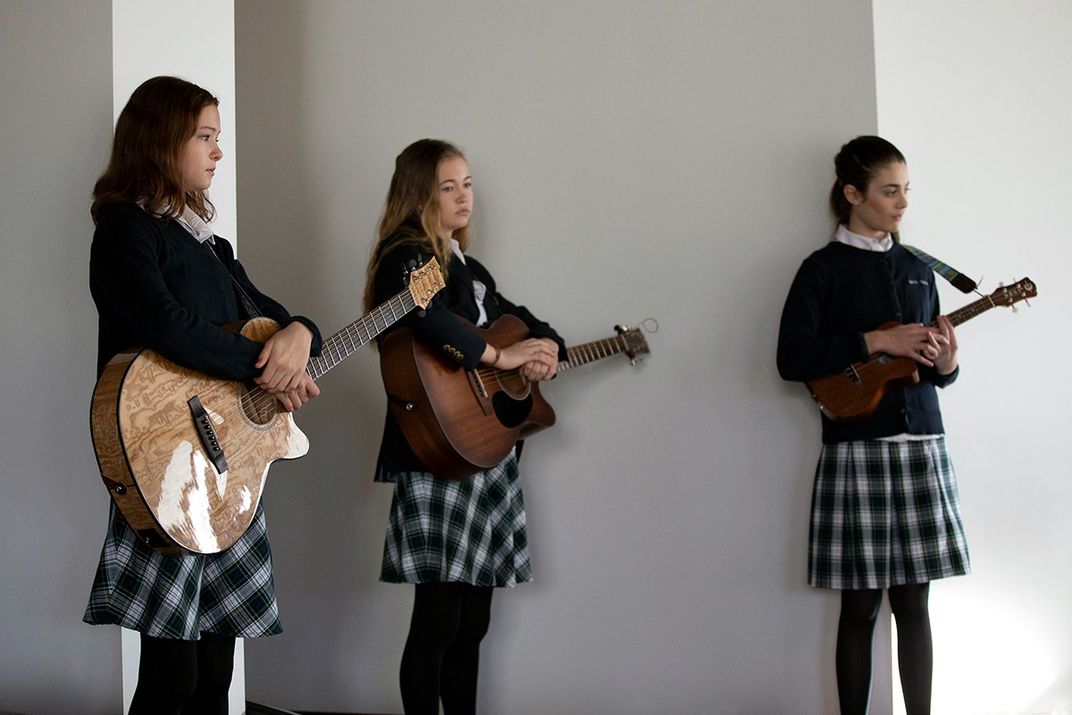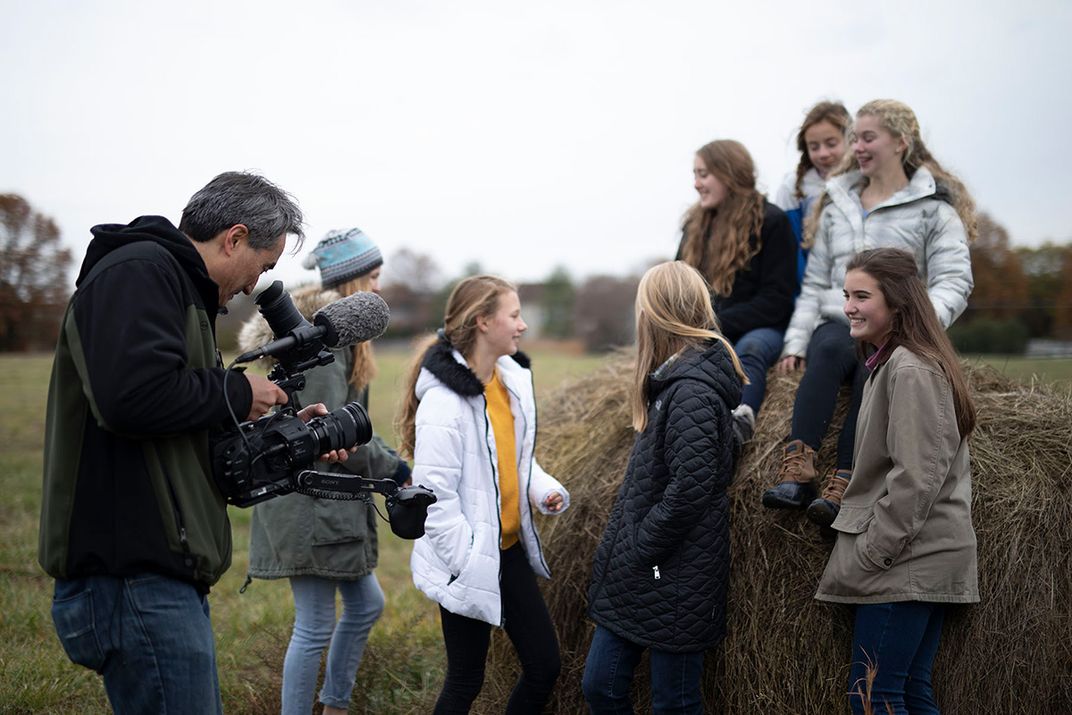How a Choral Director and Her Students Found Joy in the Folkways Archives
Watch this uplifting video giving voice to stalwarts of the American songbook
:focal(657x320:658x321)/https://tf-cmsv2-smithsonianmag-media.s3.amazonaws.com/filer/35/13/35132afb-559d-4581-8a6c-df9a2537f05b/oakcrest-choir-rui_barros_photography.jpg)
Americans place great merit in the spirit of the individual, but we also understand that great strength is found in community. In music, the stirring voice of a fine soloist, that one soul reaching out to find and communicate with others can be generous and breathtaking, but when a group of voices seek together to form a choral community, the effect can inspire beyond words.
America loves its choruses. The popularity of 2009 television program Glee and the 2012 Pitch Perfect series stand as evidence that choruses hold a time-honored place in the broader American culture. A study conducted by Chorus America in 2009, found that 42.6 million Americans sing in choruses, and there are more than 270,000 active choruses in the United States: 41,000 in high schools, 216,000 religious choirs, 12,000 professional groups. The study found that when students come together to sing, the resulting educational impact is discipline, teamwork and increased civic involvement in later life. And in keeping with the narrative and themes of Glee, belonging to a chorus certainly helps you survive the multiple challenges of high school.
To learn more about high school choruses, a team from Smithsonian Folkways Recordings contacted Anne Miller, the choral director of Oakcrest, an all-girls school in Vienna, Virginia. Would she help us with an idea? Were choruses and choral directors aware of the great wealth of Americana, as well as World Music held in the Smithsonian Folkways collections? Would they be interested in mining this vast archive for competitions and concerts? We asked Miller to do some exploring, to find a song that spoke to her and her students? Figuring that school choir directors do so every day, we called on her to produce an arrangement for her talented high school choir to sing. For our part, we would produce a performance video of their effort, so together, we could encourage other choruses to investigate the great musical heritage of this country.
Miller understood immediately what we were getting at, that what Folkways offers is more than music—it’s music with a story—and that maybe, the investigation of some of those stories was something the country’s choral students should engage with today.
Miller is a retiring woman with ice-blue eyes. In the 1980s, she finished her masters in piano performance, and still owns the good posture to prove it. She graduated from the only school she applied to, SUNY Fredonia, a campus set in a vast sweep of maples off Lake Erie and well-known for its music program. She has taught at Oakcrest School for the past 17 years. “I was hired to establish the music program,” Miller says. “In my mind, I was only going to be here for a year. I never wanted to teach large groups. I preferred one-on-one interaction. I thought I’d see all these kids looking at me for something and I would think, I don’t know who you are.” But once things got underway, the same students came back year after year and she admitted to herself that she had “fallen in love with teaching.”
/https://tf-cmsv2-smithsonianmag-media.s3.amazonaws.com/filer/08/02/08022c7b-d269-48a4-9e93-d714c48f2310/oakcrest-anne-miller.jpg)
Miller began searching the Folkways collection for inspiration. We talked over her ideas. Film producer Albert Tong was brought in to co-direct the video and late last fall, we went to visit Oakcrest’s choral room, where Miller ran through with us her selections for the young women of her chorus. A couple of us had never stood so close in front of a singing choir. It was an emotional experience hearing their voices so clearly. The graceful lines of melody they sang, the thoughtful pauses and builds evoked a sense of spaciousness. We told the students we were grateful to them for bringing their music to our audiences.
Miller had decided that one song wasn’t enough. This was a Glee-style mashup, but the goal wasn’t to crack the Nielsen top ten. She had chosen to begin with “This Land is Your Land,” the Woody Guthrie standard.
“When we started the project, the refugee crisis was in the news,” Miller says. “The immigration crisis at the border was very much on my mind when I heard Guthrie sing those lines Nobody living can ever stop me, as I go walking that freedom highway.” It was a strange choice for her.
“I remember singing ‘This Land’ as a kid in school, and of course you only sing the three happy verses. Even then, I recognized that it wasn’t real, that our country was beautiful and there was much to be proud of, but there was also injustice, there was poverty, and so I never liked that song. I was born in 1962. We were often in front of the television in the evenings, we would see the Vietnam war protests and as this little kid, I would be praying for an end to the war and what I would learn was social unrest.”
But during her investigations into the Folkways collection, she located Guthrie’s lyrics in their entirety. “And I started looking at this song and I thought—wow,” Miller says, and here her voice picks up steam. “This song is about both the beauty of our country and its injustices. This was a great song that gave me the sense that we’re all in this together. I needed to teach my students this song and have them wrestle with truth and ambiguity. And with truth being so questioned now in our society, help them work towards finding it.”
The second song she chose was the Stephen Foster parlor song, “Hard Times Come Again No More,” which asks the fortunate to remember those less fortunate. You’ll find a differently worded, Mormon version in the Folkways collection, a story in itself. But the integrity of Foster, the song’s creator, is often questioned.
“Maybe the most powerful rendition of that song is Mavis Staples’, right?” Miller asks. “And yet Stephen Foster had a history of writing blackface minstrel songs. This wasn’t a minstrelsy song, but it’s tough, the ambiguity these questions can bring, and today, we’re in this ‘cancel culture.’ Conversation is the only way to understand.”
Miller discussed the songs with her students, they talked over the histories involved, and finally she asked them to bring their own feelings, their own interpretations to each song.
“A chorus is a group of people working for a common cause. But a lot of soul-searching goes on,” Miller says. “You’re singing as part of this group, but what are your own feelings? And you get to know how others are responding. A chorus is unified, but contains the individuality of each person, along with their personal history. It’s also valuable to them as a group of young women to come together to express something.”

According to Miller, this is why you won’t ever see the same expression on all the singers’ faces. She recalls the happier verses of the Guthrie song. “Even with ‘This Land is Your Land,’ some of the girls are smiling, others are more introspective. The wealth of the song comes forward through connections, which are personal, and I have found that there are often great depths in the quietest students with the least expressive faces.”
Contrary to what I expected, Miller had arranged only one song in her long career, a responsorial psalm. “I was terrified about this,” she admits, smiling. “It was hard to decide. Should ‘Hard Times’ go at the beginning? At first, it did, and then I alternated verses, but as I learned more about ‘This Land’, the verses that were so often left out, I convinced myself.” To express the depth of that song, as well as the imperfect history of the country, she had to put the verses of ‘Hard Times’ in the middle. “They drew more attention to those left-out verses so they would be noticed. Our country good and bad. It was important to give voice to that.”
We filmed on a cold, late November day in Northern Virginia, beginning in the chorus room at Oakcrest and ending in Fairfax County’s Frying Pan Farm Park, which resembles if nothing else, a working farmstead with a bright red barn and cornfields. We were told that school groups bus to the park to learn the basics of agricultural life.
The plan was to edit after the new year so as to bring the video out well before the school year’s final concerts and graduation. But things don’t always go as planned. The pandemic erupted, the world shut down. “And then we all became quarantined,” Miller says.
The weeks dragged on into May. “The semester ended strangely and online,” Miller says. The school substituted a virtual concert for the usual robust end-of-year event. “We wanted to keep the kids singing, so we had them all send video files individually. I got tendinitis from the editing, lining up all the student’s voices. In one group, there were 40 voices,” she says.
That virtual evening culminated with the debut of the “This Land/Hard Times” video. The students were seeing it for the first time. It soon became apparent to Miller that for the chorus the project had now gained new meanings.
“We had wanted to end the arrangement in an uplifting way—'Nobody living can ever stop me'—and in the video, we saw the joy of running across fields and jumping off haystacks, playing king of mountain, where they could all hug and run freely. They could see their classmates and remember that time when they were all singing together, expressing together, and it brought them joy and freedom, even though it had been freezing outside with everyone hugging each other to keep warm. And some of them wrote to me that after the sequestering is all over, they want to remove themselves from social media and electronic gadgetry and spend real physical time together,” she says.

A couple more weeks passed and the seniors in the choir graduated online without the usual fanfare and celebrations, and toward an uncertain college start. Miller began to wonder when it would ever be safe for choirs to sing together again. The news of how COVID-19 spread through a choral group in Washington state was heartbreaking.
And then came the violent death of George Floyd and the protests that swept the country’s cities. America began a new and vital conversation with itself. “Now we’re in the middle of these protests in all of our cities because of racial injustice, and so now maybe what the students sang takes on another meaning,” Miller wonders. “And I’m hoping the video takes on a good meaning and one my students see. I wanted to end the arrangement in hope, that you can make a difference—"Nobody living can ever make me turn back"—that’s what brought tears to my eyes at the end of the singing; that freedom and joy we reach for in a bigger sense, where everyone feels valued and freed.”
Smithsonian Folkways Recordings would like to encourage choir directors across the world to take a journey through the traditional songs of the Folkways collection. We invite you to learn the songs and stories, to illuminate the true histories of this country and others through the traditional songs you share with singers and audiences, your communities.
A version of this article first appeared in the online publication of the Smithsonian Center for Folklife and Cultural Heritage.
/https://tf-cmsv2-smithsonianmag-media.s3.amazonaws.com/accounts/headshot/endnotes-gallery-19.jpg)


/https://tf-cmsv2-smithsonianmag-media.s3.amazonaws.com/accounts/headshot/endnotes-gallery-19.jpg)